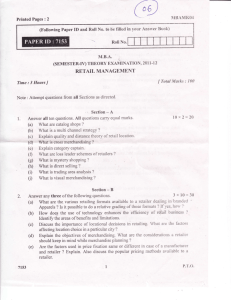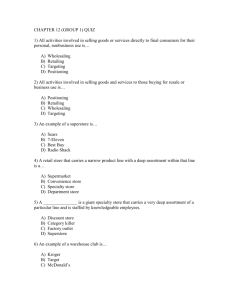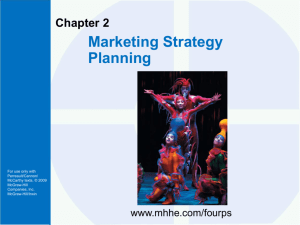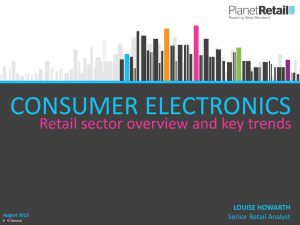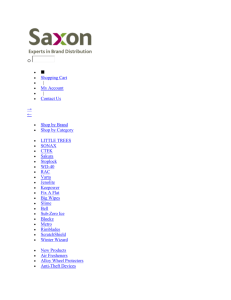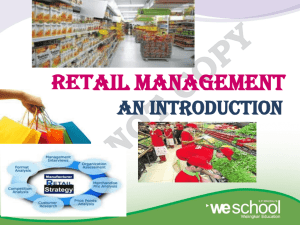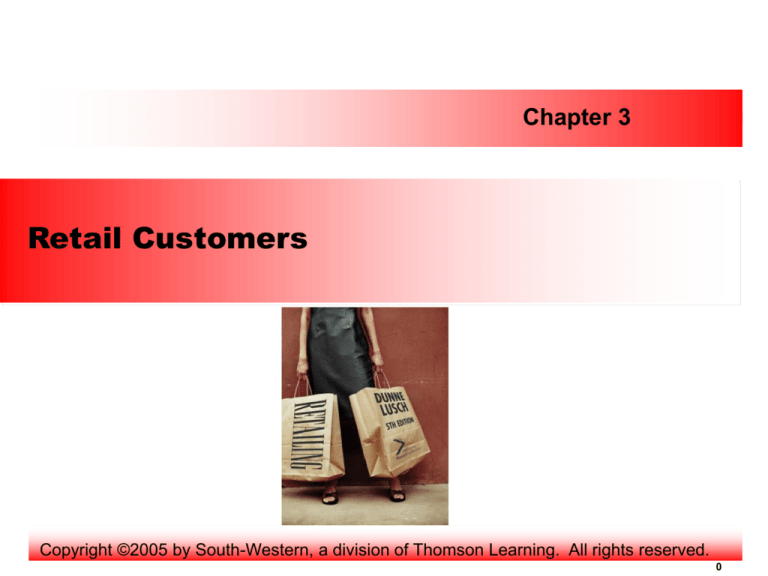
Chapter 3
Retail Customers
Copyright ©2005 by South-Western, a division of Thomson Learning. All rights reserved.
0
Learning Objectives
• Explain the importance of population trends to the
retail manager.
• List the social trends that retail managers should
regularly monitor and describe their impact on
retailing.
• Describe the changing economic trends and their
effect on retailing.
• Discuss the consumer shopping/purchasing model,
including the key stages in the shopping/purchasing
process.
1
Retail Mix
Introduction
• The combination of merchandise, assortment, price,
promotion, customer service, and store layout that
best serves the segments targeted by the retailer.
2
Customer Satisfaction
Introduction
• Occurs when the total shopping experience of the
customer has been met or exceeded.
3
Retail Growth
Introduction
Starbucks Coffee has
experienced explosive
growth over the last five
years and thus has had to
put considerable effort into
planning for and recruiting
human resources at all
levels in the organization.
In fact, Starbucks was the
first American retailer to
provide its part-time
employees (65 percent of its
workforce) full health care
benefits and stock options.
4
Consumer Spending
Exhibit 3.1
5
Customer Services
Introduction
Include the activities the retailer performs that
influence (1) the ease with which a potential customer
can shop or learn about the store’s offering, (2) the
ease with which a transaction can be completed once
the customer attempts to make a purchase, and (3) the
customer’s satisfaction with the purchase.
6
Market Segmentation
Introduction
Market Segmentation
Is the dividing of a heterogeneous consumer
population into smaller, more homogeneous groups
based on their characteristics.
7
Current Trends Affect the Way the
Consumer Behaves
Population
Trends
Exhibit 3.2
Societal
Trends
Consumer Shopping/
Purchasing
Model
Economic
Trends
8
Question to Ponder
Given the wide variety of population, social, and
economic trends, and the importance to retailers of
targeting specific consumer groups, what segments
provide the greatest opportunities for new retailers
today?
9
Population Trends
LO 1
• Population Growth
• Age Distribution
• Geographic Trends
10
Population Trends
LO 1
• Population Variables
Include population growth trends, age distributions,
and geographic trends.
11
Number of Births by Year
LO 1
12
Where did the term Melting Pot originate?
LO 1
The Melting Pot is the name of a play about
immigrants written by Israel Zangwell. In the
play, which opened in Washington D.C. in 1908,
one of the characters declared:
“America is…the great melting pot
where all the races of Europe are
melting and reforming Germans and
Frenchman, Irishmen and Englishmen, Jews
and Russians into the crucible he will be the
fusion of all races, the coming superman.”
13
Boomers, Xers and Yers
LO 1: Exhibit 3.3
14
Texas Consumers’ Percentage of National
Average Usage
LO 1: Exhibit 3.4
15
Texas Consumers’ Percentage of National
Average Usage
LO 1: Exhibit 3.4
16
Geographic Trends
LO 1
Micromarketing Merchandising
Is the tailoring of merchandise in each store to the
preferences of its neighborhood.
17
Geographic Trends
LO 1
Metropolitan Statistical Areas
Are freestanding urban areas with populationd in
excess of 50,000.
18
Generation Gap in the Information Age
LO 1
Those who say...
Change brings exciting opportunities
They want to be their own boss
They own a computer
They’ve used E-mail
They have Internet access
Social Security will not be available to them
Medicare will not pay any of their health expenses
Technology brings more confusion and
complications than it does exciting opportunities
It is difficult to use computers
Under 30
Age 50
or over
78%
58%
72%
85%
52%
54%
23%
58%
46%
40%
28%
21%
14%
6%
18%
15%
38%
53%
19
Global Retailing
LO 1
20
Global Retailing
LO 1
21
Social Trends
LO 2
•
•
•
•
Education
State of Marriage and Divorce
Makeup of the American Household
Changing Nature of Work
22
U.S. Education Levels
LO 2
23
Makeup of American Households
LO 2
100
80
60
Other
40
Living Alone
Single Parents
20
Other Married
Married with
Children
0
1990
2000
Year
2010
SOURCE: U.S. Bureau of the Census, Statistical Abstract of the United States: 1996 (116th edition)
Washington, D.C., 1996. Based on data contained in Tables 60, 61, 66, 67,68.
24
Makeup of American Households
LO 2
“ Mingles” Unmarried Couples
Increased 167% since 1980
7% of couple households
25
Makeup of American Households
LO 2
Boomerang Effect
Occurs when grown children return home to live
with their parents.
26
Economic Trends
LO 3
•
•
•
•
Income Growth
Personal Savings
Women in the Labor Force
Widespread Use of Credit
27
Share of Aggregate Income Received by Each Fifth and the Top 5
Percent of U.S. Households, 1970-2000
LO 3: Exhibit 3.5
28
Changing Purchasing Habits of American
Households
LO 3
25
Medical
20
15
Food
Recreation
10
5
Clothing
0
1970
1980
1990
2004
Year
SOURCE: Vision for the New Millennium . . .(Atlanta: Kurt Salmon Associates, 1997). Used with permission
29
Economic Trends
LO 3
Disposable Income
Is personal income less personal taxes.
30
Economic Trends
LO 3
Discretionary Income
Is disposable income minus the money needed for
necessities to sustain life.
31
Spenders and Savers as a % of Total
Population 1965 to 2025
LO 3
40
Percent
35
Spenders
( Age 20 to 44)
Savers
( Age 45 to 64)
30
25
20
15
1965
1970
1975
1980
1985
1990
1995
2000
2005
2010
2015
2020
2025
Year
SOURCE: Based on data from U.S. Bureau of the Census, Population Paper Listings PPL. 41, Current Population
Reports P25-1130, U.S. Census of Population (1970), volume 1, Part B, Census of Population (1980) volume 1, part B.
32
The % of Women Age 16 and Over in the
Work Force
1945
1950
1960
1975
1990
2000
LO 3
35.80%
33.90%
37.70%
46.30%
57.50%
62.60%
33
Growth in Consumer Credit
LO 3
34
Square Feet of Retail Space Per Capita
LO 3
20
16
12
Amount of space
needed to support
Market Demand
8
4
‘72 ‘74
‘76
‘78
‘80
‘82
‘84
‘86
‘88
‘90
‘92
‘96
‘98
‘00
35
Consumer Behavior Model
LO 4
•
•
•
•
•
•
Stimulus
Problem Recognition
Active Information Gathering (Search)
Evaluate Alternatives
Purchase
Post-Purchase Evaluation
36
Consumer Behavior Model
LO 4
• Stimulus
Refers to a cue that is external to the individual or a
drive that is internal to the individual.
37
Consumer Behavior Model
LO 4
• Cue
Refers to any object or phenomenon in the
environment that is capable of eliciting a response.
38
Consumer Behavior Model
LO 4
• Drive
Refers to a motivating force that directs behavior.
39
Consumer Shopping/ Purchase Model
LO 4: Exhibit 3.6
Problem Solving
Stimulus
Problem
Recognition
Active
Information
Gathering
(Search)
Evaluate
Alternatives
Purchase
PostPurchase
Evaluation
40
Consumer Behavior Model
LO 4
Passive Information Gathering
Is the receiving and processing of information
regarding the existence and quality of merchandise,
services, stores, convenience, pricing, advertising,
and any other factors that a consumer might consider
in making a purchase.
41
Consumer Behavior Model
LO 4
Problem Recognition
Occurs when the consumer’s desired state of affairs
departs sufficiently from the actual state of affairs,
placing the consumer in a state of unrest.
42
Consumer Behavior Model:
Problem Solving
LO 4
Habitual problem solving
Occurs when the consumer relies on past experiences
and learning to convert the problem into a situation in
which less thought is required. The consumer has a
strong preference for the brand to buy and the retailer
from which to purchase it.
43
Degrees of Consumer Problem Solving in
Shopping/Purchasing
LO 4: Exhibit 3.7
Retailer
Preference
Brand
Preference
Strong
None or Weak
Strong
None or Weak
Habitual
Problem
Solving
Limited
Problem
Solving
Limited
Problem
Solving
Extended
Problem
Solving
44
Consumer Behavior Model:
Problem Solving
LO 4
Limited Problem Solving
Occurs when the consumer has a strong preference
for either the brand or the store, but not both.
45
Consumer Behavior Model:
Problem Solving
LO 4
Extended Problem Solving
Occurs when the consumer recognizes a problem but
has decided on neither the brand nor the store.
46
Consumer Behavior Model
LO 4
Active Information Gathering
Occurs when consumers proactively gather
information.
47
Consumer Behavior Model
LO 4
Attributes
Refers to the characteristics of the store and its
products and services.
48
Consumer Behavior Model
LO 4
Evaluate Alternatives
Occurs when consumers make judgements regarding
the individual product attributes of a retailer and/or
product.
49
Consumer Behavior Model
LO 4
Purchase
The purchase stage may include final negotiation,
application for credit if necessary, and the
determination of the terms of purchase.
50
Consumer Behavior Model
LO 4
Post-Purchase Evaluation
Consumer perceptions toward the retailer and/or
product purchased after use and evaluation.
51
Consumer Behavior Model
LO 4
Post-Purchase Resentment
Arises when after the consumer becomes dissatisfied
with the product, service, or retailer and thus begins to
regret the purchase was made.
52
Additional Slides
53
Population Trends
LO 1
Population
Growth
Age
Geographic
Distribution
Trends
54
Social Trends
LO 2
Education
State of
Marriage
and Divorce
Makeup of the Changing
American Nature of
Household Work
55
Economic Trends
LO 3
Income
Growth
Personal
Savings
Women in
the Labor
Force
Widespread
Use of
Credit
56



